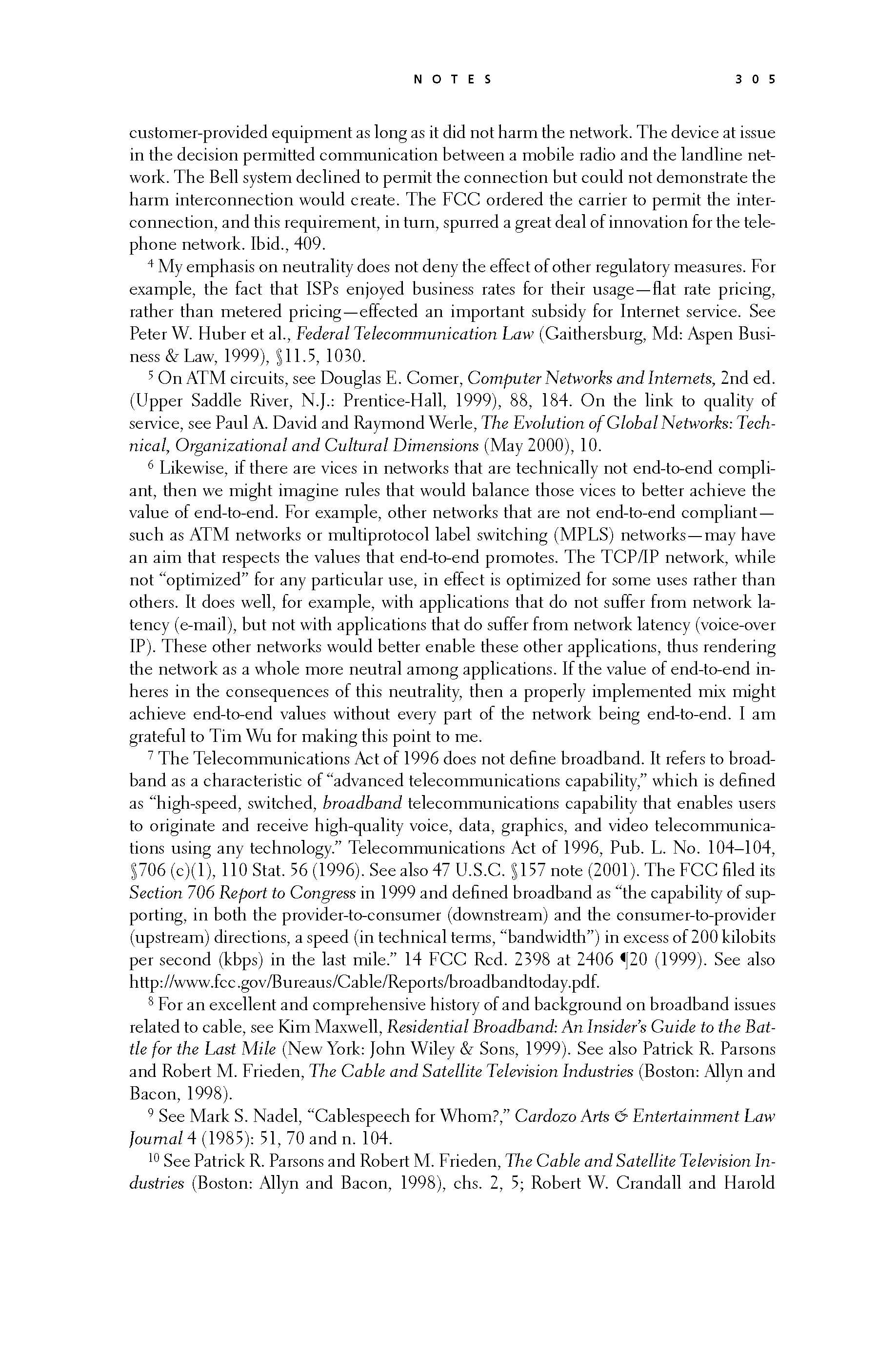 p304 _
-chap- _
toc-1 _
p305w _
toc-2 _
+chap+ _
p306
p304 _
-chap- _
toc-1 _
p305w _
toc-2 _
+chap+ _
p306
customer-provided equipment as long as it did not harm the network. The device at issue
in the decision permitted communication between a mobile radio and the landline net-
work. The Bell system declined to permit the connection but could not demonstrate the
harm interconnection would create. The FCC ordered the carrier to permit the inter-
connection, and this requirement, in turn, spurred a great deal of innovation for the tele-
phone network. Ibid., 409.
[10-4] My emphasis on neutrality does not deny the effect of other regulatory measures. For
example, the fact that ISPs enjoyed business rates for their usage -- flat rate pricing,
rather than metered pricing -- effected an important subsidy for Internet service. See
Peter W. Huber et al., _Federal_Telecommunication_Law_ (Gaithersburg, Md: Aspen Busi-
ness & Law, 1999), #11.5, 1030.
[10-5] On ATM circuits, see Douglas E. Comer, _Computer_Networks_and_Internets,_ 2nd ed.
(Upper Saddle River, N.J.: Prentice-Hall, 1999), 88, 184. On the link to quality of
service, see Paul A. David and Raymond Werle, _The_Evolution_of_Global_Networks:_Tech-_
_nical,_Organizational_and_Cultural_Dimensions_ (May 2000), 10.
[10-6] Likewise, if there are vices in networks that are technically not end-to-end compli-
ant, then we might imagine rules that would balance those vices to better achieve the
value of end-to-end. For example, other networks that are not end-to-end compliant
-- such as ATM networks or multiprotocol label switching (MPLS) networks -- may have
an aim that respects the values that end-to-end promotes. The TCP/IP network, while
not "optimized" for any particular use, in effect is optimized for some uses rather than
others. It does well, for example, with applications that do not suffer from network la-
tency (e-mail), but not with applications that do suffer from network latency (voice-over
IP). These other networks would better enable these other applications, thus rendering
the network as a whole more neutral among applications. If the value of end-to-end in-
heres in the consequences of this neutrality, then a properly implemented mix might
achieve end-to-end values without every part of the network being end-to-end. I am
grateful to Tim Wu for making this point to me.
[10-7] The Telecommunications Act of 1996 does not define broadband. It refers to broad-
band as a characteristic of "advanced telecommunications capability," which is defined
as "high-speed, switched, _broadband_ telecommunications capability that enables users
to originate and receive high-quality voice, data, graphics, and video telecommunica-
tions using any technology." Telecommunications Act of 1996, Pub. L. No. 104-104,
#706 (c)(1), 110 Stat. 56 (1996). See also 47 U.S.C. #157 note (2001). The FCC filed its
_Section_706_Report_to_Congress_ in 1999 and defined broadband as "the capability of sup-
porting, in both the provider-to-consumer (downstream) and the consumer-to-provider
(upstream) directions, a speed (in technical terms, "bandwidth") in excess of 200 kilobits
per second (kbps) in the last mile." 14 FCC Rcd. 2398 at 2406 #20 (1999). See also
http://www.fcc.gov/Bureaus/Cable/Reports/broadbandtoday.pdf.
[10-8] For an excellent and comprehensive history of and background on broadband issues
related to cable, see Kim Maxwell, _Residential_Broadband:_An_Insider's_Guide_to_the_Bat-_
_tle_for_the_Last_Mile_ (New York: John Wiley & Sons, 1999). See also Patrick R. Parsons
and Robert M. Frieden, _The_Cable_and_Satellite_Television_Industries_ (Boston: Allyn and
Bacon, 1998).
[10-9] See Mark S. Nadel, "Cablespeech for Whom?," _Cardozo_Arts_&_Entertainment_Law_
_Journal_ 4 (1985): 51, 70 and n. 104.
[10-10] See Patrick R. Parsons and Robert M. Frieden, _The_Cable_and_Satellite_Television_In-_
_dustries_ (Boston: Allyn and Bacon, 1998), chs. 2, 5; Robert W. Crandall and Harold
[[305]]
p304 _
-chap- _
toc-1 _
p305w _
toc-2 _
+chap+ _
p306